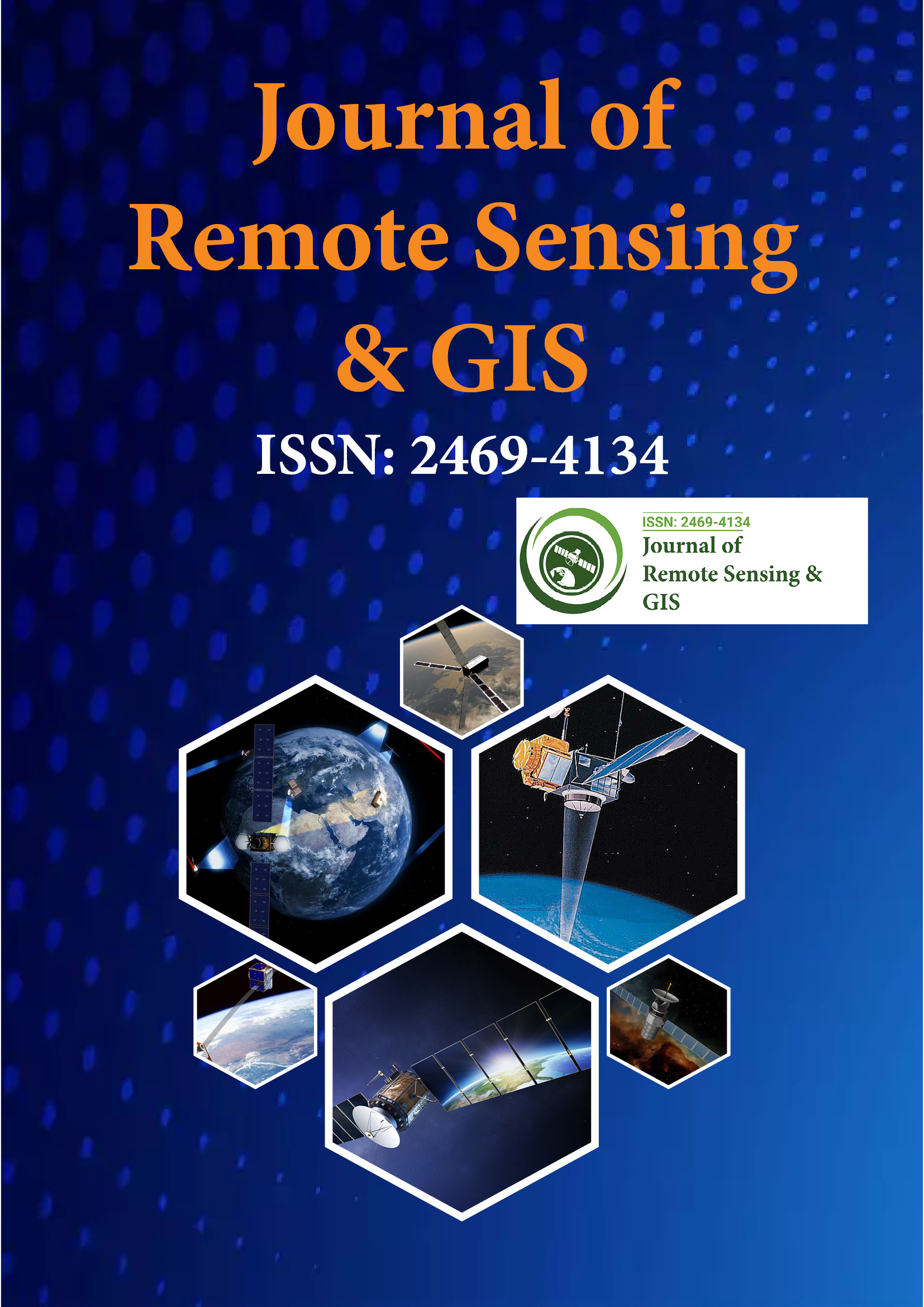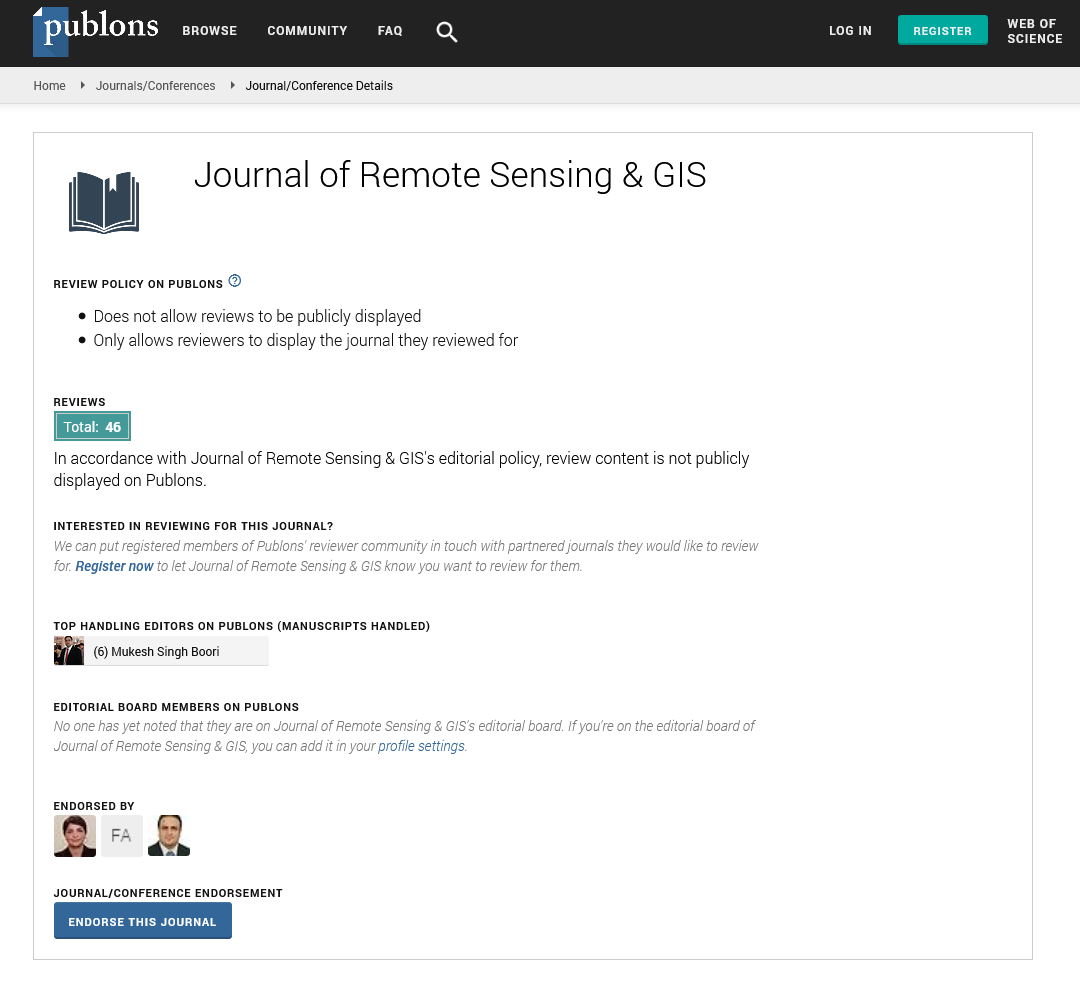Indexed In
- Open J Gate
- RefSeek
- Hamdard University
- EBSCO A-Z
- OCLC- WorldCat
- Publons
- International Scientific Indexing
- Euro Pub
- Google Scholar
Useful Links
Share This Page
Journal Flyer

Open Access Journals
- Agri and Aquaculture
- Biochemistry
- Bioinformatics & Systems Biology
- Business & Management
- Chemistry
- Clinical Sciences
- Engineering
- Food & Nutrition
- General Science
- Genetics & Molecular Biology
- Immunology & Microbiology
- Medical Sciences
- Neuroscience & Psychology
- Nursing & Health Care
- Pharmaceutical Sciences
Perspective - (2025) Volume 14, Issue 1
Remote Sensing for Sustainable Agriculture: Integrating Spatial Data with Farm Management Practices
Emmanuel Henrik*Received: 25-Feb-2025, Manuscript No. JGRS-25-28689; Editor assigned: 27-Feb-2025, Pre QC No. JGRS-25-28689 (PQ); Reviewed: 14-Mar-2025, QC No. JGRS-25-28689; Revised: 21-Mar-2025, Manuscript No. JGRS-25-28689 (R); Published: 28-Mar-2025, DOI: 10.35248/2469-4134.25.14.375
Description
Agriculture, as a foundational element of global food systems, has increasingly adopted advanced technologies to address modern challenges such as climate variability, land degradation, water scarcity and the demand for higher productivity. Among these technologies, remote sensing has emerged as a powerful tool for observing and analyzing agricultural systems across large spatial and temporal scales. By collecting data from satellites, aircraft and Unmanned Aerial Vehicles (UAVs), remote sensing enables farmers, researchers and policymakers to make informed decisions regarding crop health, land use, resource allocation and sustainability.
Principles and types of remote sensing
Remote sensing refers to the acquisition of information about objects or areas from a distance, typically using electromagnetic radiation. In agriculture, it involves detecting reflected or emitted radiation from the earth's surface to interpret the condition of crops, soil and water resources. There are two main types of remote sensing:
Passive remote sensing: Passive sensors detect natural energy, usually sunlight, reflected or emitted from the earth's surface. These include multispectral and hyperspectral sensors used on satellites like Landsat, Sentinel and MODIS. They are commonly used for vegetation mapping, soil characterization and crop monitoring.
Active remote sensing: Active systems emit their own energy toward the target and measure the reflected signal. Examples include radar and LiDAR. These systems can operate regardless of daylight or cloud cover, making them suitable for continuous monitoring of agricultural fields.
Applications in crop monitoring
One of the most common applications of remote sensing in agriculture is the assessment of crop conditions throughout the growing season. Satellite imagery can detect variations in plant health using vegetation indices, such as the Normalized Difference Vegetation Index (NDVI). These indices are calculated from reflectance values in the red and near-infrared bands, which correlate with plant biomass and chlorophyll content.
By tracking NDVI over time, farmers and agronomists can identify stressed areas within fields, detect early signs of disease or pest outbreaks and estimate crop yield. High-frequency observations enable better timing of irrigation, fertilization and pesticide application, improving resource efficiency and crop outcomes.
Soil and land management
Remote sensing provides essential data for soil analysis and land management. Spectral characteristics of bare soil surfaces can reveal information about texture, organic matter, salinity and moisture content. This information helps in delineating soil zones and tailoring inputs based on local conditions.
In areas where soil erosion, salinization, or degradation is a concern, temporal imagery allows for monitoring land changes over time. Combined with digital elevation models, remote sensing can also support terrain analysis for precision farming and erosion control planning.
Water resource assessment and irrigation management
Water is a limited and costly input in many agricultural regions. Remote sensing helps monitor soil moisture, evapotranspiration and irrigation effectiveness. Thermal sensors detect canopy temperature, which can serve as an indicator of water stress.
By integrating satellite data with models such as the Surface Energy Balance Algorithm for Land (SEBAL) or the Mapping Evapotranspiration at High Resolution with Internalized Calibration (METRIC), water managers can evaluate crop water use and plan irrigation schedules accordingly. This approach supports conservation and ensures that water is distributed where and when it is needed most.
Crop mapping and acreage estimation
Remote sensing plays a key role in mapping crop types and estimating planted area. Using time-series data and spectral signatures unique to specific crops, classification algorithms can distinguish between different vegetation types. This information is valuable for national statistics, food supply forecasting and market planning.
Governments and international agencies often rely on satellitederived crop maps to assess food security, allocate subsidies and manage agricultural policies. These maps are also used to detect illegal crop cultivation or to monitor compliance with land-use regulations.
Precision agriculture and UAV applications
With the rise of precision agriculture, remote sensing has become more localized and detailed. UAVs equipped with highresolution cameras and multispectral sensors allow field-level monitoring at centimeter-scale accuracy. These platforms can rapidly assess plant variability, detect anomalies and guide targeted interventions.
Drone-based imagery is increasingly used for plant counting, growth stage analysis and damage assessment after extreme weather events. This granular data supports input optimization and enhances field productivity while minimizing waste.
Early warning systems and risk management
Remote sensing contributes significantly to early warning systems for drought, flood and pest outbreaks. By combining satellite data with meteorological and environmental indicators, analysts can detect risk patterns and predict potential impacts on agriculture.
This predictive capacity helps governments and farmers prepare for adverse conditions through timely interventions, such as adjusting planting dates, selecting resilient crop varieties, or deploying protective measures.
Limitations and integration with ground data
While remote sensing offers many benefits, it also has limitations. Cloud cover can obstruct optical imagery and satellite revisit times may not align with rapidly changing field conditions. Calibration and validation with ground-truth data remain essential for accurate interpretation.
Integrating remote sensing with field measurements, meteorological data and Geographic Information Systems (GIS) enhances reliability and utility. This fusion of data sources supports comprehensive decision-support systems that guide agricultural operations across multiple levels.
Conclusion
Remote sensing has transformed agricultural practices by providing timely, detailed and scalable data on crop, soil and environmental conditions. Through continuous technological advancements and increased accessibility of satellite imagery, it is now an integral component of agricultural monitoring and planning. As data resolution and analytical methods improve, remote sensing will continue to contribute to sustainable agricultural development and resource management.
Citation: Henrik E (2025) Remote Sensing for Sustainable Agriculture: Integrating Spatial Data with Farm Management Practices. J Remote Sens GIS.14:375.
Copyright: © 2025 Henrik E. This is an open-access article distributed under the terms of the Creative Commons Attribution License, which permits unrestricted use, distribution and reproduction in any medium, provided the original author and source are credited.

